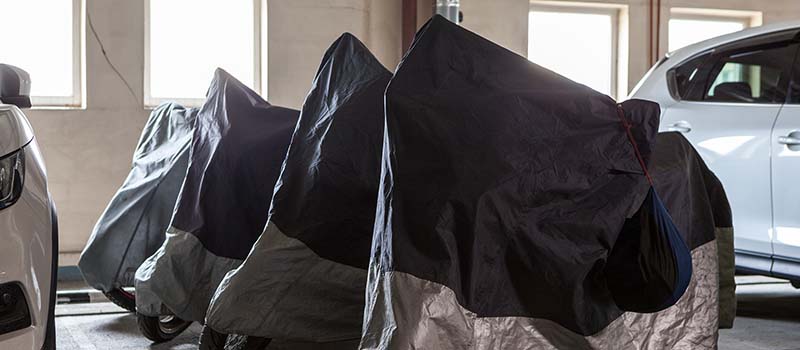Storing Your Motorcycle Over The Winter
Storing Your Motorcycle Over The Winter

Storing Your Motorcycle Over The Winter
- Find an appropriate place for storage. Ideally, you’ll want a controlled environment in which your bike can be stored out of the elements, like a garage. If you’re storing your vehicle outside, you’ll want to select a location that’s not exposed to road salt or snow plows. It’s also best to select a place that provides some sort of protection, like a carport or breezeway. Avoid parking your bike near trash receptacles, as this increases the risk of rodent invasion. Indoor commercial motorcycle storage can be costly, but it might be a great option if you’re concerned about longer-term exposure to the elements.
- Prepare your fuel system. If you’re getting ready to store your bike for the winter, try to use pure gasoline (rather than an ethanol blend) during the last few times you refuel. Ethanol gasoline tends to absorb water vapor, so using pure gasoline will reduce problems related to water in your gas tank. The day you plan to put your bike into storage, go for a ride and get the engine warm, fill your tank and add fuel stabilizer. After that, ride at least 10 miles to ensure that the stabilizer has worked its way through your fuel system.
- Change your oil. Even if your engine isn’t due for an oil change, you’ll want to do it right before putting it into storage to reduce the risk of damage. Oil with acidic combustion byproducts can damage your motor when left sitting for months.
- Give your bike a thorough cleaning. Take the time to clean all parts of your bike, including the saddle and side covers. You’ll want to remove any grime that could hold moisture and cause rust to form over the winter. You may also want to consider waxing your bike, in order to protect the paint.
- Check on your battery. Inspect the terminals for corrosion, and clean and apply dielectric grease, if needed. Check your battery’s charge to make sure it’s as close to the ideal range (12.75 volts) as possible. If the battery’s charge is low, charge and retest it. You’ll want to decide whether you’re going to remove the battery from your bike all together and maintain the charge, or leave it in and use a trickle charger. If you’re storing your bike outdoors, chances are that removing the battery will be a better choice for you.
- Prepare your exhaust. You may want to consider purchasing commercially-made plugs for your exhaust pipes, especially if you’re storing your bike outdoors or in a shed. This will help prevent unwelcome entry to your exhaust by rodents looking for a place to build a nest. You can also use other plastic to cover those openings, but avoid using anything that holds moisture to prevent rust from forming. Regardless of what you’re using, be sure to remember to remove these items before starting your bike in the spring.
- Check your tire condition and pressure. Make sure your tires are at the correct pressure before storing your bike, and if possible, check the pressure once a month. You’ll also want to check your tires for signs of cracking or heavy wear, and consider replacing them before you hit the road again if they’re in poor condition.
- Cover your bike properly. If you’re storing your bike outdoors, you’ll want to invest in a high-quality cover to protect it from snow, ice and other elements that can cause damage. Do not use a plastic tarp or cover, as it will hold moisture, which can ultimately result in rust or other damage. If your bike is stored indoors, you may not need a cover for it, but remember that even a light cover can help prevent dust from collecting.
Whether your bike is in storage or you’re getting ready to hit the road, you’ll want to have the right insurance coverage to protect your motorcycle from damage. Reach out to your local agent with any questions, and they’ll be happy to provide their expertise to get you the coverage that meets your needs.
